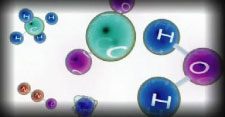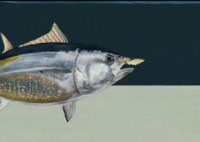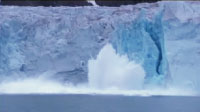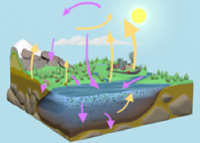 |
NASA | GSFC | JPL | Site Map |
|
|
 |
 |
Education: Student Outcomes |
Filtered by outcome, asset type: 9-12q5, video Click here to begin a new search | ||||||||||||||||||||||||||||||||||||||||||
Outcome: Describe how changes in the ocean's circulation can produce large changes in climate. | ||||||||||||||||||||||||||||||||||||||||||
Grade level: 9-12 Theme: climate Video: keeping_up_carbon_01.flv
Understanding the carbon cycle - and how it is changing - is key to understanding Earth's changing climate. On land, plants remove carbon from the atmosphere through photosynthesis. Animals eat plants and either breathe out the carbon, or it moves up the food chain. When plants and animals die and decay, they transfer carbon back to the soil. Moving offshore, the ocean holds huge amounts of carbon - about 50 times the amount we find in the atmosphere. Stacey Boland: "The ocean is sometimes called a carbon sink, meaning that it absorbs, or takes up carbon from the atmosphere. It takes up carbon through physical and biological processes." (source) Grade level: 9-12 Theme: climate Video: keeping_up_carbon_02.flv
Over long time scales, this process has made the ocean floor the largest reservoir of carbon on the planet. Most of the ocean's nutrients are in cold, deep water. In a process called upwelling, currents bring nutrients and carbon up to the surface. Carbon can then be released as a gas back into the atmosphere, continuing the carbon cycle. By cycling huge amounts of carbon, the ocean helps regulate climate. Scott Doney: "So when you think of climate, you don't often think of the ocean. With climate - you think of, is it going to be hotter this year, or is it going to be colder this year? But the oceans are actually a great regulator, a controller of Earth's climate. And they even are controlling how much carbon is in the atmosphere, which can slow down how quickly climate change is occurring." (source) Grade level: 9-12 Theme: climate Video: melting_ice_01.flv
Josh Willis: "I prefer not to think about climate change and global warming in terms of doom and gloom scenarios, so much as a change in our planet. Our planet's definitely changing, and we're definitely causing it. So we're going to have learn to deal with some of these changes. But in addition, we're going to have to learn how to make a slightly smaller footprint on our planet." Josh Willis: "Sea level is rising effectively because of global warming. As the planet heats up, two things happen to the ocean. One is that the temperature of the water increases. And as that happens, the water actually expands and takes up more room. The other thing that happens is that ice that was on land in the form of glaciers and ice sheets begins to melt and as that runs off into the ocean, it increases the water in the ocean, and it actually raises sea level as well. (source) Grade level: 9-12 Theme: climate Video: CarbonCycleFinal_ipod.m4v.flv
On land, plants remove carbon from the atmosphere through photosynthesis. Animals eat plants and either breath out the carbon, or it moves up the food chain. When plants and animals die and decay, they transfer carbon back to the soil. Moving offshore, the ocean takes up carbon through physical and biological processes. At the ocean's surface, carbon dioxide from the atmosphere dissolves into the water. Tiny marine plants called phytoplankton use this carbon dioxide for photosynthesis. Phytoplankton are the base of the marine food web. After animals eat the plants, they breathe out the carbon or pass it up the food chain. Sometimes phytoplankton die, decompose, and are recycled in the surface waters. Phytoplankton can also sink to the bottom of the ocean, where they become buried in marine sediment. Over long time scales, this process has made the ocean floor the largest reservoir of carbon on the planet. In a process called upwelling, currents bring cold water containing carbon up to the surface. As the water warms, the carbon is then be released as a gas back into the atmosphere, continuing the carbon cycle. Carbon is found in the atmosphere as carbon dioxide, which is a greenhouse gas. Greenhouse gases act like a blanket, and trap heat in the atmosphere. In the past two centuries, humans have increased atmospheric carbon dioxide by more than 30 percent, by burning fossil-fuels and cutting down forests. (source) | ||||||||||||||||||||||||||||||||||||||||||



